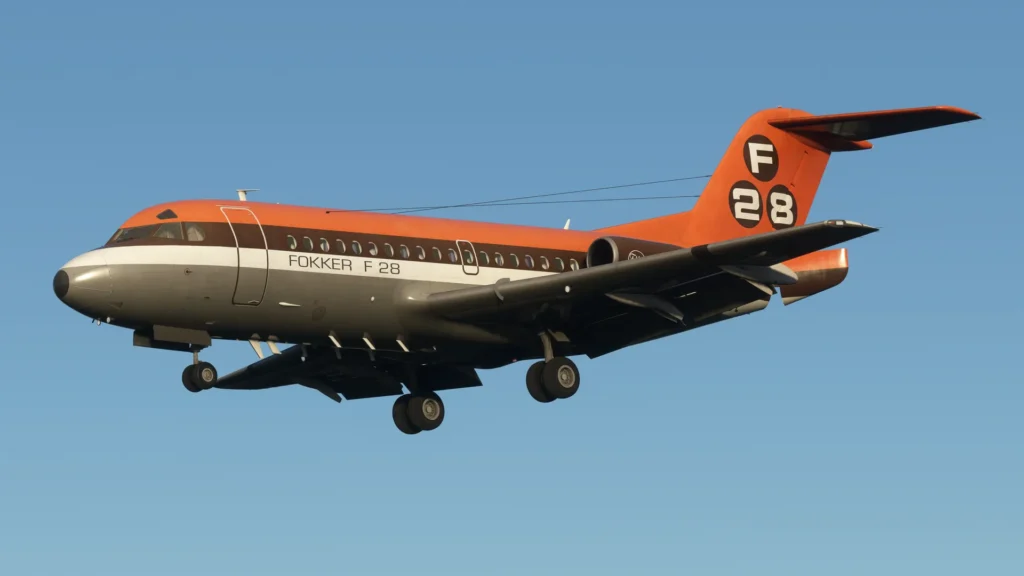
Ein überarbeitetes Flight Control System, bessere Bugradsteuerung, noch mehr Systemtiefe, neues Leben in der Kabine und vieles mehr: Just Flight hat ein umfassendes Update der F28 Professional veröffentlicht. Version 1.2 steht jetzt für den Microsoft Flight Simulator bereit.
Just Flight hatte die F28 im Juli veröffentlicht. Danach folgte bereits ein umfassendes Update. Die jetzt erschienene Version 1.2 enthält folgende Verbesserungen:
v1.2
Completely reworked flight control system to provide an even deeper level of simulation. Features include:
– Fully simulated First Mode, Second Mode and Third Mode operation of all flying control surfaces.
– Alternate controls for the flaps and stabilisers which operate at the correct speed and with an accurate electrical power drain.
– Realistic simulation of hydraulic accumulators as such that once hydraulic power is lost, certain flying controls can only be operated once before hydraulic accumulator pressure is drained (for example, speedbrakes can only be extended or retracted once on accumulator pressure).
– Accurate feel when a flying control surface has hydraulic power removed. Elevator is 4x harder to operate with no hydraulic pressure and the efficacy and force required to move the ailerons and rudder various with indicated air speed.
– Improved Liftdumper operation including improve deployment and retraction logic and increased drag when deployed. Once deployed, liftdumpers can now only be retracted if disarmed or if throttles are advanced beyond 75% HP rpm. The liftdumper lever can now also be controlled using the default MSFS reverse thrust control assignments THROTTLE CUT and DECREASE THROTTLE (F1 and F2 keys on a keyboard).
– Improved speedbrake “blow back” feature for more effective speedbrake behaviour above 190 knots.
Completely reworked landing gear and nose wheel steering systems. Features include:
– Improvements to alternate gear extension logic. Landing gear doors now need to be manually closed using a winch control on the EFB after an alternate extension. The control will appear automatically on the AIRCRAFT page after an alternate extension.
– Brakes now work for a limited time on hydraulic accumulator pressure after a hydraulic system failure.
– Nose wheel steering system re-coded from the ground up for a much-improved nose wheel steering behaviour when using the tiller.
– Rudder is now compatible with default Xbox Controller control assignments.
– Added TOGGLE GPWS control assignment to control U/C HORN SILENCER button.
New additions and improvements to the Electronic Flight Bag (EFB):
– “Auto Jetway” EFB option added to toggle the automatic jetway connection when converting the passenger door into a jetway configuration (GSX users may wish to set this to OFF if you experience a conflict with the GSX jetways)
– “TO Thrust Light” EFB option added to toggle logic that will illuminate the NAV Transfer Failure light on the glareshield when the throttles are in the detent position.
– EFB configuration options not being saved over multiple flights – fixed
– EFB bug when manually entering a ZFW and pressing “Enter” would cause the ZFW weight to differ from the inputted value – fixed
– EFB AIRCRAFT page resets to full brightness when closed and reopened – fixed
– Random weight button on EFB could set weights that were greater than the maximum possible weight in each cargo hold – fixed
– Aircraft state saving logic only saving the aircraft’s state on the flight it is enabled on – fixed
– Added landing gear door winch controls to close the landing gear doors after an alternate landing gear extension.
Various logic improvements to the Digital Fuel Flow Display:
– RAMP weight displayed on the Digital Fuel Flow Display can now be adjusted using the SET WT knob. The RAMP weight will automatically be set to match the actual aircraft weight when loading into the aircraft, and can then be manually adjusting. If a significant change is made to the aircraft weight on the EFB, then the RAMP weight will automatically resync to the new weight.
– Pressing the RAMP or CONS buttons will now hold the respective information on the top display until the other button is pressed.
– TEST I and TEST II are now more accurately following the test procedure in the manual.
And even more new features, improvements and fixes:
– New F28 Mk.1000 Braathens S.A.F.E livery added
– New F28 Mk.4000 Linjeflyg livery added
– Completely reworked model and texturing of the cabin crew panels in the forward galley.
– With the AUTO CABIN CREW option enabled on the EFB, random CABIN and TOILET calls from the passengers will be triggered and later cancelled by the crew automatically throughout the climb, cruise and descent phases of flight, whenever the seat belt signs are switched off. These calls are indicated by the illumination of the associated lights on the forward galley stewardess panel as well as audible chimes. CABIN calls can also be disabled by pulling any of the “Reading Lights” circuit breakers on the lower cabin crew panel, and TOILET calls by disabled by pulling the “Toilet” circuit breaker.
– Forward galley stewardess panel backlighting is now affected by the stewardess panel circuit breakers.
– Improved autopilot PITCH and ROLL engagement behaviour to reduce the tendency for the nose to dip slightly upon autopilot engagement.
– Improved autopilot IAS mode engagement behaviour to reduce the tendency for the nose to dip slightly upon IAS mode engagement.
– Improvements to IAS mode behaviour when changing target altitude during altitude capture sequence. The autopilot can now detect and react to a change in selected altitude during the altitude capture sequence.
– Various improvements to the stabiliser trim to fix an issue where flying the aircraft near its centre of gravity limits could cause a runaway trim issue and an uncommanded descent.
– Fixed bug where engaging the autopilot on the ground prior to flight would cause PITCH mode issue when the autopilot is engaged in flight
– Autopilot PITCH and trim issues which could cause a runaway trim situation in certain weight and balance configurations – fixed
– Aggressive autopilot PITCH mode engagement on second flight of a session – fixed
– Improved autopilot behaviour when capturing an altitude to reduce the likelihood of pitch oscillations when flying the aircraft at low MTOW configurations with no GPS selected. In certain edge cases, the aircraft may still experience some pitch oscillations when no GPS is selected, which can be nullified by applying gentle opposite pressure on the yoke. We are continuing to investigate this.
– VOR and ILS test functionality – added
– Completely reworked GS MAN flight director code to work around conflicts when flying an ILS approach with the Working Title GNS530 selected.
– Various other Working Title GNS530 conflicts with autopilot and flight director systems – fixed
– ADF tuning would sometimes increase/decrease in 0.4KHz intervals – fixed
– Top and Bottom beacon lights cannot be controlled individually – fixed
– Detent animation added to the left hand throttle.
– Logo lights now automatically switch off when the aircraft is airborne and the flaps are selected UP.
– Utility System hydraulic pumps logic – improved
– Flight Control System hydraulic pumps logic – improved
– Hydraulic system flight control panel logic – improved
– Hydraulic LOW TANK PRESS caution lights overly sensitive and should not illuminate during normal operation – fixed
– Minor livery bugs – fixed
– GPWS glideslope warning logic improved at lower altitudes. The glideslope warning will no longer play when the aircraft is below 300ft AGL.
– Glideslope indications reversed when capturing an ILS with the VHF NAV 2 radio – fixed
– Landing light LVAR is permanently ON causing complications when using the F28 Professional with virtual airlines’ – Fixed
– Fuel low pressuring lights logic – improved
– Fuel crossfeed pre-flight check logic – improved
– Improved fuel flow logic in the centre tank to ensure the PUMP CENTRE TANK lights briefly illuminate whilst fuel pressure builds.
– Outside Air Temperature Gauge scale inaccuracies – fixed
– First Officer Progress Annunciator test not illuminating amber GPS annunciator – fixed
– PITCH command tooltip showing reversed angle – fixed
– Collins IND-40 digital DME display showing actual ground speed rather than slat range rate – fixed
– Flight director and heading bug visibility at night – improved
– Flaps gauge animation range increased to improve accuracy when the gauge is not supplied with electrical power.
– Speedbrakes gauge animation range increased to improve accuracy when the gauge is not supplied with electrical power.
– Speedbrake gauge animation range increased to improve accuracy when the gauge is not supplied with electrical power.
– Added support for CENTRE AILER RUDDER control assignment.
– Reduced overall brightness of cabin lights.
– Reduced overall brightness of cockpit DOME and STORM lights.
– Engine ignition system and igniter lights logic – improved
– Added a few second delay between opening the fuel fire shutoff guard and the engine shutting down to simulate the engine consuming the fuel remaining in the fuel lines between the valve and the engine.
– Altimeter knob animation issue – fixed
– Radio altimeter logic does not reset after landing, causing radio altimeter alerts to play during climb out of the second flight in a session – fixed
– Improved GPWS alert logic during flaps 25 approaches. The correct GPWS callouts now play and at the correct times whenever the GPW override switches are in the down position with guards closed.
– Added support for AILERON LEFT (ROLL LEFT) and AILERON RIGHT (ROLL RIGHT) control assignment to fix issue where keyboard users were not able to roll the aircraft.
– APU START button rotation animation and dimming function removed to reflect the button in real aircraft.
– Missing flight attendant callouts when toggling the fasten seatbelts switch – fixed
– Pilot callouts better optimised for headset simulation.
– Aircraft warnings better optimised for headset simulation.
– Added diminishing jet whine with altitude.
– Buffeting/overspeed sounds playing at speeds slightly lower than the barber pole at low altitudes – fixed
– Model gap between boundary layer fence and wing lead edge – fixed
– Black line visible around the centre of the fuselage when moving your camera away from the aircraft – fixed
– Adjusted position of wingtip static wick on 1000/2000 based on newly discovered reference material.
– Glass domes added to magnetic indicators on overhead panel and magnetic indicator emissive texture tweaked.
– Updated 8K texture set (IMPORTANT! If using the 8K texture set you first must update the F28 followed by the 8K texture set in order for the textures to display correctly)
– “Course Bar Active” callout triggers adjusted. The callout will now only trigger once the course bar is moving across the HSI.
– “Localiser” and “Glideslope” callout triggers adjusted. Both of these callouts now correctly play as cautionary callouts and will only trigger if the aircraft deviates 1 dot left/right of the localiser, or 1 dot up/down of the glideslope after intercept has occurred.
– Constant Speed Drive indicators not illuminated with engines shutdown – fixed
– Cabin crew announcements are not audible in the aft cabin – fixed
– MSFS automatic copilot would turn on cockpit air instead of cabin air during the pre-flight check cockpit checklist – fixed
– MSFS automatic copilot would not press the RESET button on the hydraulic system flight control panel during the after starting checklist – fixed
– Dome/Storm light can now be controlled using the PEDESTAL LIGHT control assignment.
– Various main menu updates (thumbnails updated to reflect livery fixes, airline naming updated to reflect correct spelling on liveries, content manager thumbnail updated).
– Updated operations manual
– Updated EFB manual

